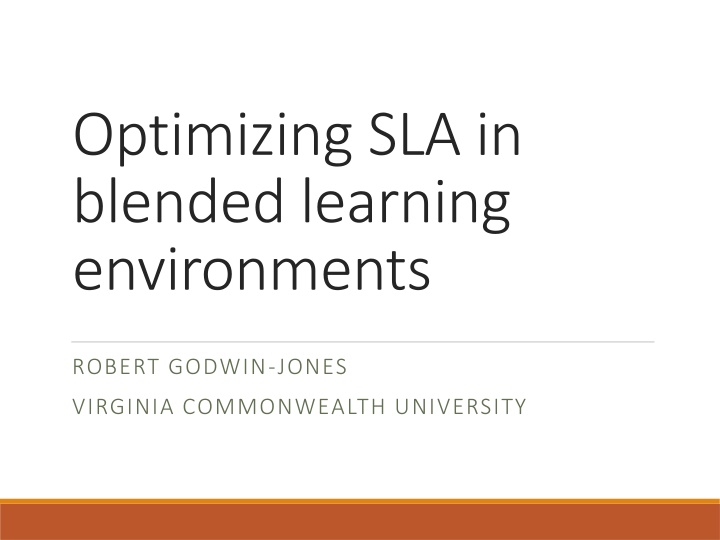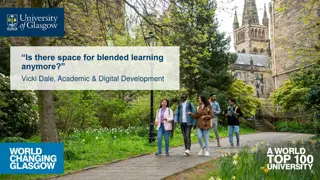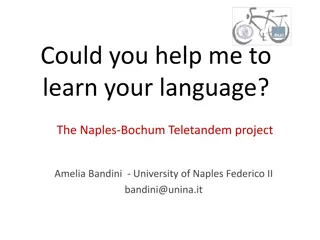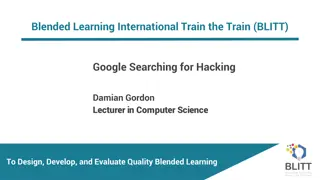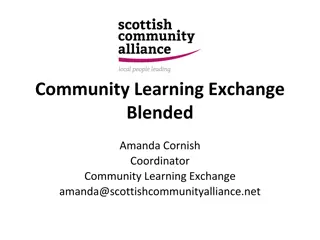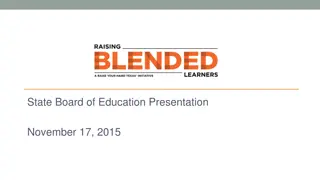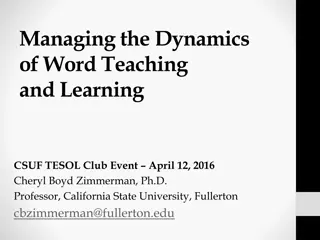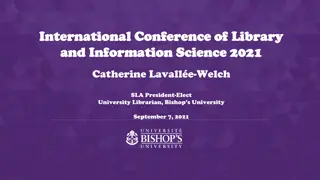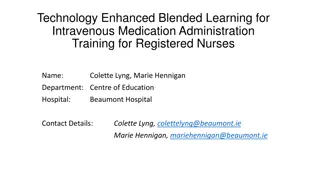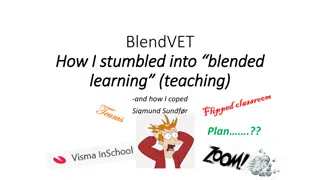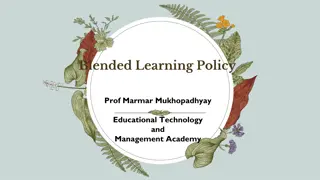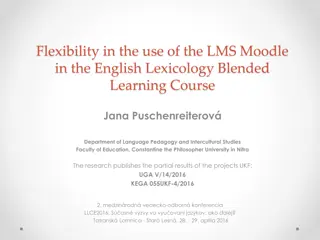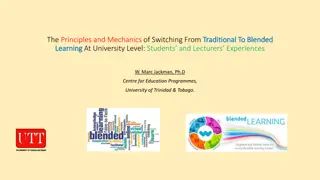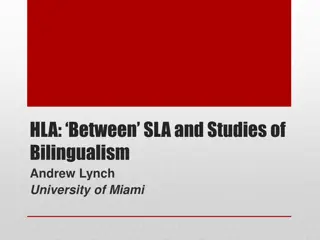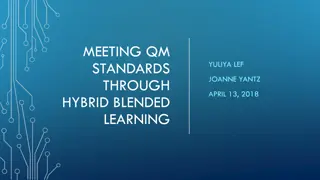Optimizing SLA in Blended Learning Environments
Presentation outlines the concept of a porous classroom, benefits, challenges, and best practices of hybrid learning formats. Explores leveraging online and local resources, mobile devices in education, and future learner engagement strategies.
Uploaded on Apr 12, 2025 | 2 Views
Download Presentation

Please find below an Image/Link to download the presentation.
The content on the website is provided AS IS for your information and personal use only. It may not be sold, licensed, or shared on other websites without obtaining consent from the author.If you encounter any issues during the download, it is possible that the publisher has removed the file from their server.
You are allowed to download the files provided on this website for personal or commercial use, subject to the condition that they are used lawfully. All files are the property of their respective owners.
The content on the website is provided AS IS for your information and personal use only. It may not be sold, licensed, or shared on other websites without obtaining consent from the author.
E N D
Presentation Transcript
Optimizing SLA in blended learning environments ROBERT GODWIN-JONES VIRGINIA COMMONWEALTH UNIVERSITY
Outline of presentation What is a porous classroom and why would I want one? Translating into classroom practice: Hybrid or blended format Benefits and Challenges Course set-up and materials selection Examples, lessons learned, and best practices
What is a porous classroom? Coined by Breen, 1999 (in lnterpreting the Postmodern Condition ): Boundaries between the classroom, the school, the society, and the world are seen to be permeable [Larsen-Freeman, 2018, p. 64 ] The classroom walls become its windows [Breen, 1999, p. 55]
Porosity in <=> out of classroom Online communities but local as well When available, leverage nearby language resources, ethnic communities, heritage clubs Opportunity for service learning components: civic & linguistic engagement Mobile devices Phones in the classroom controversial but bridges gap between academia & real world Use to extend class activities, enable group projects, connect to online [Godwin-Jones, 2018] Future learner selves Combine language learning with future professional and personal pursuits Provide opportunities for individual exploration thru online sources [Mathieu et al., 2019]
Classroom porosity => Hybrid Hybrid or blended format Normal implementation: reduced contact hours, supplemented by work online Mix can vary from 20% to 80% online; combine best of both formats Flipped classroom Usually references the practice of moving lectures out of class to digitized access at home Idea is to free up class time for active learning; grammar/vocab at home not in class Learning outcomes Project studies/meta-analyses: at least equivalent to F2F outcomes (McCarthy, 2016) Ideal for digital natives; seen as transformative , format of the future (Grgurovic, 2017)
Why hybrid in language learning? Rationale is often not primarily pedagogical Often impetus is to save money and reduce staff (Anderson, 2018) Reality: If done right, can be transformative but also more expensive Principal advantage: Flexibility Unlimited options in terms of how much and what kind of online resources to integrate Opportunity to differentiate learning to accommodate different student needs/goals Digital literacy Helps in development of metalinguistic skills, knowledge of approaches to learning Potential to motivate and promote autonomous learning; enable life-long skills
What do online resources offer? Access to authentic materials Wealth of materials for native speakers in all languages Includes written texts and multimedia => multimodal literacy Multiple opportunities of written and oral language use through technology Texting services such as WhatsApp Videoconferencing: Skype, Facebook Messenger, many others Opportunities for social connections Social media: Facebook, Twitter, Instagram and country-specific versions Commercial services like Babbel or Duolingo: tutorials and conversation
Informal language learning Demonstrated incidental language learning Using online resources for entertainment/socialization with language as byproduct Recent studies show improvements in receptive & productive skills (Godwin-Jones, 2018) Resources and rationale Video/audio streaming (subtitles/lyrics); social media; online gaming; language services Aligns with usage-based views of language: patterns over rules (Ellis, 2017) Caveats Most studies focus on learners beyond the novice level Almost all target English learners; resources for other languages vary
Rise of smart devices Advances in artificial intelligence + big data => Natural language processing Popularity and usefulness of virtual assistants: Alexa, Siri, Google Assistant Multilingual capabilities and translation services, embedded in Internet of Things Use in support of language learning, not as replacement Virtual assistants used in pronunciation exercises and speaking practice Google Translate increasingly used for first drafts in professional & educational settings Integration into formal instruction Usefulness of modeling use and discussing capabilities/limitations of services/devices Likelihood that teachers can learn from students on innovations in this area
Linguistic diversity Voices beyond the classroom instructor Exposure to variety of speakers, in real time or asynchronously Including regional dialects, other variations from standard language Different language registers and digital uses From formal language in television broadcasts to informal YouTubers Digital platforms prepare students for real world in which online language use vital Exposure to multilingualism Superdiversity and translanguaging increasingly characterize digital world Practice in using online tools/services to decipher and engage
Collaborative/cultural integration Peer-to-peer and native speaker interactions Opportunities for experiencing interactions in the target language Development of linguistic skills as well as strategic and pragmatic competence Negotiating language and culture Through exchanges such as eTandem or through multilateral platforms [Lang Forward!] Can be organized as class exchanges or on individual basis Intercultural communication competence Person-to-person encounters can dispel stereotypes and promote tolerance Need for critical reflection supplied through mediation and written
Challenges Language learning different from other disciplines Not just content delivery but a skill needed to be practiced (communicative method) Fours skills and 5 C s (ACTFL) development including speaking ability Integration of formal and informal learning Textbook used may not be well suited to hybrid format In-class and out-of-class activities need to be well integrated and support each other Bringing everyone on board; upfront and ongoing support Teachers may be anxious about 1) technology use, 2) new pedagogy, 3) losing control Studies show best results are for serious students, high achievers ; target laggards too
Setting up for hybrid delivery Start with pedagogy What are the end goals? Target proficiency level? Move existing F2F class or start new? Consider a design-based approach: deliberative, iterative process [ADDIE/TPACK models] Choose mix of face-to-face and online that aligns with context Curricular goals and practical concerns (tech support, part-time or grad student teachers) Resources available locally (language lab, tech gurus, supportive administrators) Plan out assessment strategy Use traditional in-class assessments (quizzes, tests) and online homework scores Evaluate individual language gains through journals, recordings, presentations, interviews
What online materials to use? Most commonly used in hybrid courses [according to Lomicka & Lord, 2019] Learning Management System [LMS]: Blackboard, Canvas, Moodle Publisher-supplied websites or electronic workbook; self-graded exercises Issues with LMS and publisher sites LMS not designed for language learning; closed environment Publisher sites: Vary in quality; mechanical drills; determines course content Alternatives: Add-on options such as Open Educational Resources (OER) OER: Provides more flexibility in content ordering and content options But requires local development or use of 3rdparty OER; coordination across sections
Best practices and lessons learned: Setting up the course Make informed choice among many different models Mix of in-person and online may differ according to language, available resources Start with desired outcomes, work back to determine optimal hybrid structure Explore tech options that provide flexibility and interest If using publisher-supplied web sites, consider supplementing with OER, other sources Encourage and enable individual learning trajectories; use mobile devices Provide sufficient training to instructors, support staff, students Need for all involved to understand goals and responsibilities, including students Everyone should have a reasonable comfort level and competence with tech used
Best practices and lessons learned: Optimizing the format Make well thought-out and fully-developed plan before semester starts Make sure all tech resources have been set up and continue to be available Clear and explicit syllabus, online directions, expectations; indicate sources for support Good communication and student buy-in Be transparent and explicit about course structure and goals; don t change mid-stream Regular check-ins; open communication lines; take feedback seriously Emphasize to students The critical importance of keeping on schedule, completing assignments before class The expectation to become self-reliant, autonomous learners, but group work vital too
Best practices and lessons learned: Teaching effectiveness In course design, use each format for what it does best Off-load grammar, drills, vocab exercises, videos to computer; in-class grammar a waste Expect students to come prepared to engage in active language use; don t redo lessons Avoid in-class grammar presentations (especially in the L1) At most, quick summary in L2; use student-led interactions; consider input processing When possible, emphasize inductive learning from samples: corpora, authentic language Keep class actively engaged in L2 Small group work; mini-projects; skits, games & contests => real communication tasks L1 use permitted when needed; same goes for mobile devices
Mobiles in blended learning Do they belong in the classroom Distraction factor. Depends on class size/dynamic Easier integration of formal & informal learning Options Limit use to particular activities Use for homework assignments Ignoring mobiles Makes learning English a purely academic exercise Does not set up students for informal and life-long learning => G-J white paper
Group sessions Explore/discuss mobile apps Language tools: dictionaries, translators, grammar guides Writing tools: Grammarly, Google Docs, ChatGPT Messaging apps Others? Summarize in Google Doc
